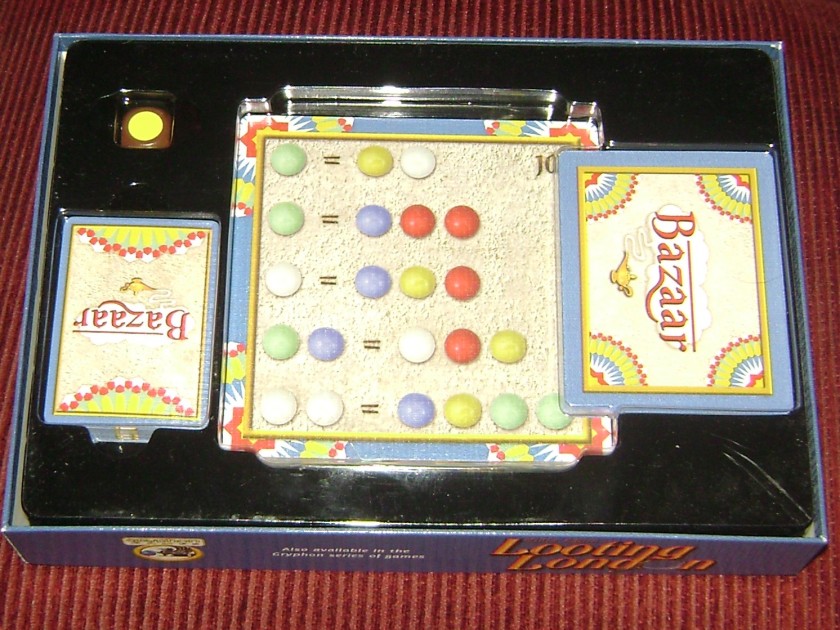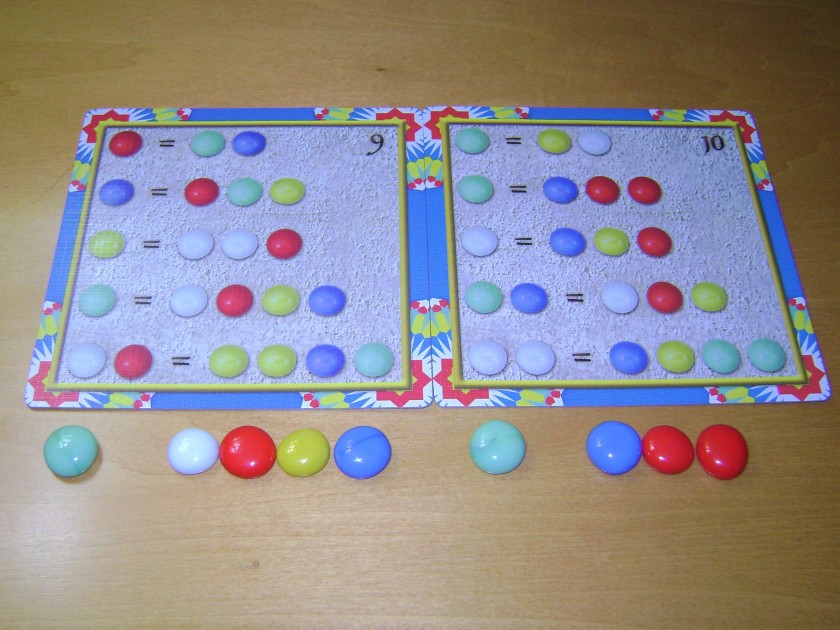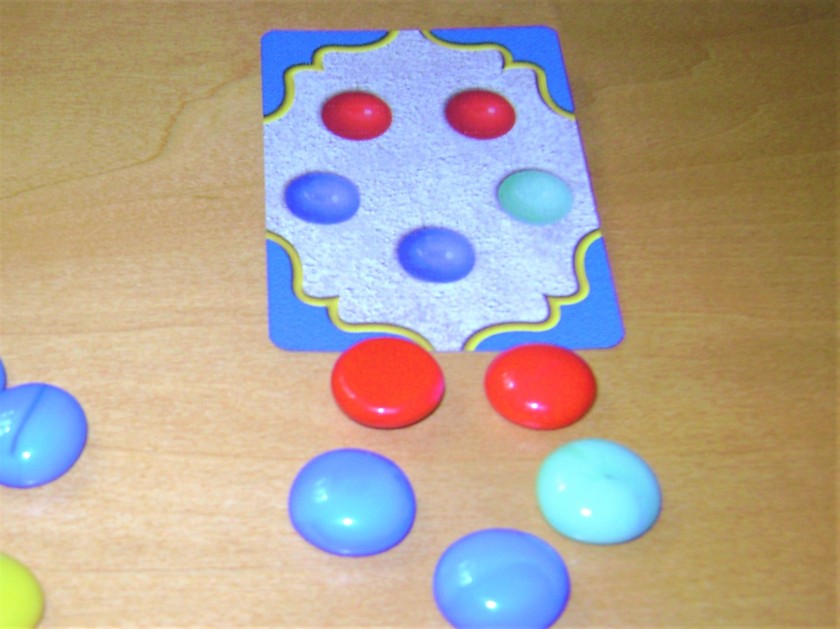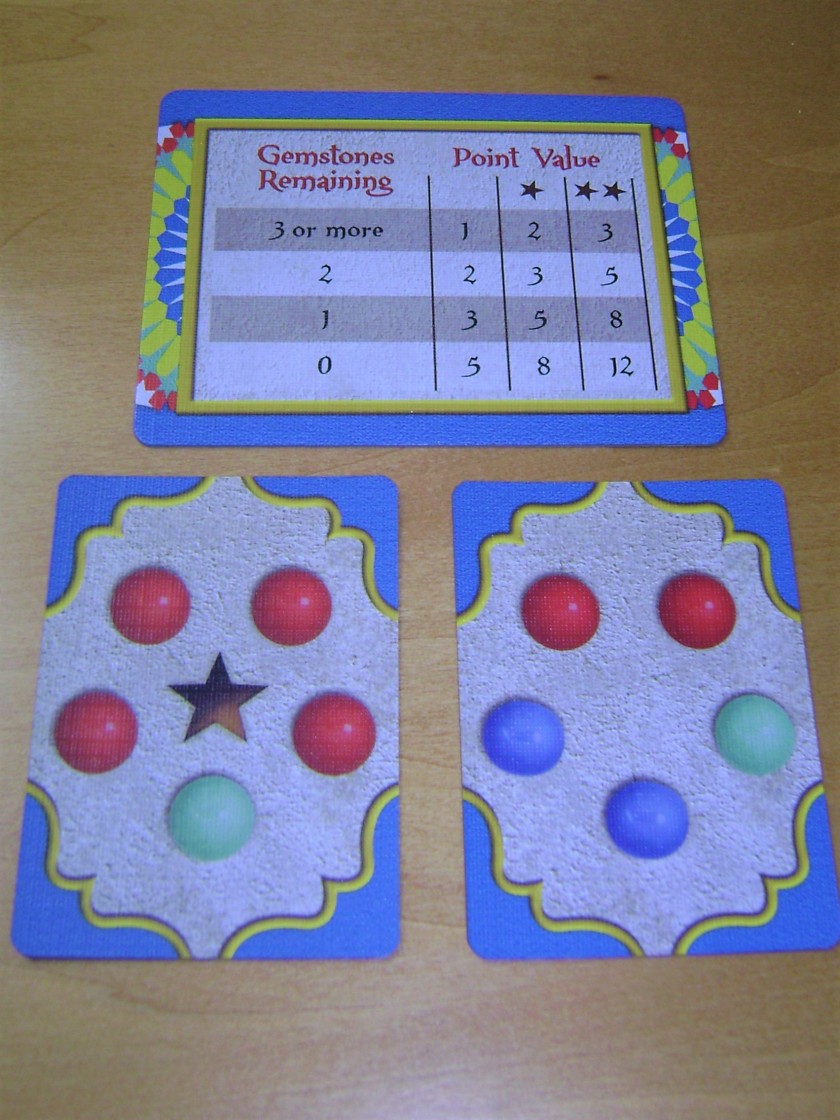We played Bazaar for the first time the beginning of September although this game has been around for over 50 years I have only recently stumbled across it. It was created by renowned game designer Sid Sackson and first published in 1967 as part of the 3M bookshelf series of games. There was a re-print in the late 80’s I’m seen 1987 versions floating around on E-Bay. My version is produced by Gryphon Games (2011).

Object of the Game: To collect and trade stone in the correction combination to purchase wares, worth varying point, from the bazaar. The winner is the player with the highest point total when the bazaar closes.
Number of players: 2 to 6
Average Time to Play: 30-45 minutes. Our first time took almost 45 minutes with three people. If you have players spending a lot of time analyzing their moves or more players at the table, the average time maybe closer to an hour.
Age Range: Ages 8 and up, from the game description. The age range we played with was 11 to 83.
Game Components: This is favorite of mine just for the incredible components. Included in the game are:
- 10 Exchange cards. You play with two cards each game and each card has five equations for stone exchanges, for a total of 10 exchanges.
- All the cards in this game are thick and well made with clear graphics and print.
- 6 Player reference cards, one for each player to help with scoring.
- 1 Bazaar die-each face has one of the five stone colors and the sixth face has a genie lamp which lets you pick any color stone.
- 45 Ware cards. These are the items you will be purchasing with your stones. In the Gryphon (2011) version, a few of the cards have a single star all others are plain, each have a set of five colored stones to match
- 100 Stones, twenty in each color, blue, light green, red, white and yellow. They are smooth and solid, we loved handling them.
Setup: Two exchange cards are chosen and placed face up where all players are able to reference them throughout the game. For the first game we played with one exchange card to simplify play.
Shuffle the ware cards and deal them, face down, into four piles of five cards each, the rest will not be used in the game. Turn the top card of each of the four piles over to reveal the wares for sale.

Place all the stones in a pile where players can reach, we played with someone be assigned as the banker. Players start without any stones in their possession.
In the rules, the youngest player goes first and then play continues clockwise.
How to Play: On each turn players must either roll the die to collect a stone or trade sets of stones, based upon the equation cards, into the bank. A player may make only one trade per turn.
To complete an exchange a player trades the appropriate stones based upon the equations on the exchange cards, the equations are valid both ways. So based upon the exchange card below, a player could turn in a green in exchange for the white, red, yellow and blue stones OR the could exchange the white, red, yellow and blue stones for a green one. Another possible exchange is turning in a green stone for a blue and two red stones OR exchanging a blue and two red stones for a green stone.

One the first few turns almost every player will be rolling the die. The color of the die face is the color of the stone the player collects. If a player gets the genie lamp on their role they can chose what color stone they will collect from the bank.
Players are collecting and exchanging stones to get the correct mix of stones on any of the four ware cards. Once a player has the correct set of five stones they may purchase the ware from the bazaar. The player must first roll the die or exchange stones before they can make a purchase. the stones used to purchase the ware go back to the bank, and the next card in the pile from where the purchase was made is turned up to ensure four wares are available.

To score points the player who has made a purchase uses their reference card to calculate their points. The player would first count their stones which remain after their purchase and then look to see whether their ware card has a star in the center of the stones or not. Players with the least remaining stones following a purchase score higher points and cards with a star in the center are more valuable that ones without.

So a player who purchased the ware card on the right above, with no stones remaining would score 8 points. if they had one stone left after purchase they would score 5 points.
There is a limit to how many stones each player can retain. Each player can hold onto a maximum of 10 stones. if they are over 10 stones and are called out the player to their left of the over limit player is allowed to choose the stones from the excess pile to return to the bank, return that players total back to 10 stones.
In the Gryphon (2011) rules once one entire stack of wares are purchased and only three stacks remain all the other ware become more valuable. the remaining cards without stars will now be scored as if they have a star and the cards with a single star will be valued as a two-star card.
The game ends when only two of the four ware stacks remain. We also played where the player who reaches a set amount of points first wins.
Thoughts on the game: We love playing the game, the components are colorful and engaging. it took a bit of practice to pick which ware cards we were going for and how to exchange stones for the correct ones before someone else bought your card. At play can shift quickly as new ware cards are turned over, your pile of stones which didn’t match the moment before suddenly might be in the running for the new ware card.
The scoring was a bit cumbersome, keeping tracking of how many stars and tracking left over stones but we had one score keep for all players which made it easier.
This game has been in play for over 50 years, it was fun, relatively quick and easy to learn, I highly recommend it!
There are older versions which were quite expensive on E-bay and whose components differed, I was able to purchase the Gryphon edition through Amazon and also found it here Bazaar game at Gryphon website.
Rating: 4 out of 5 hearts for its great components, fun concept.





